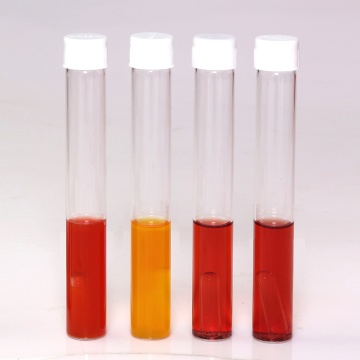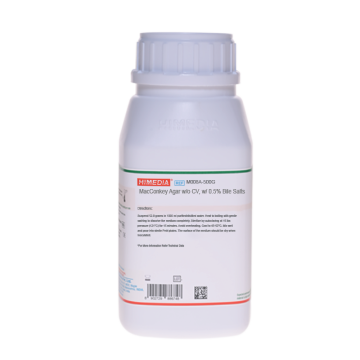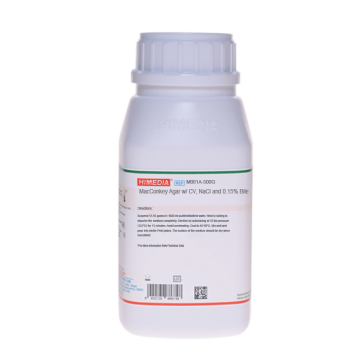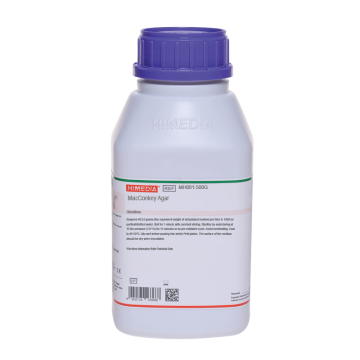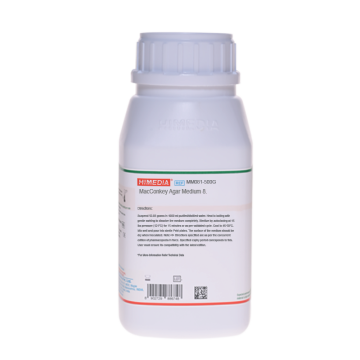 Your enquiry has been submitted
Your enquiry has been submitted
MacConkey Agar w/ CV and w/o NaCl
Intended Use
Recommended as a differential medium for the selection and recovery of the Enterobacteriaceae and related enteric gram-negative bacilli.
Composition**
| Ingredients | g / L |
|---|---|
| Peptone | 1.500 |
| Tryptone | 1.500 |
| Gelatin peptone | 17.000 |
| Lactose | 10.000 |
| Bile salts | 1.500 |
| Crystal violet | 0.001 |
| Neutral red | 0.030 |
| Agar | 15.000 |
Final pH (at 25°C): 7.1±0.2
**Formula adjusted, standardized to suit performance parameters
Directions
Suspend 46.53 grams in 1000 ml purified / distilled water. Heat to boiling with gentle swirling to dissolve the medium completely. Sterilize by autoclaving at 15 lbs pressure (121°C) for 15 minutes. Avoid overheating. Cool to 45-50°C. Mix well and pour into sterile Petri plates. The surface of the medium should be dry when inoculated.
Principle And Interpretation
The MacConkey media are well known and popular enrichment system for coliform bacteria. MacConkey Agar is the earliest selective and differential medium for cultivation of enteric microorganisms from a variety of clinical specimens (1,2). Original formulation of MacConkey included ox bile as inhibitor of gram-positive bacteria and litmus as the indicator of the acid production from lactose. Later litmus was substituted by phenol red indicator to make interpretation easier and more precise. The most significant modification to the original formulation is the substitution of ox bile by purified bile salts that improve the selectivity and avoid the inherent turbidity which is due to the fat material of the bile. Another modification was the inclusion of supplementary inhibitors such as crystal violet and pH indicator neutral red.
MacConkey Agar has been recommended for use in microbiological examination of foodstuffs (3) and for direct plating of water samples for coliform counts (4). These media are also accepted by the Standard Methods for the Examination of Milk and Dairy Products (5).
Original medium contains protein, bile salts, sodium chloride and two dyes. Omission of sodium chloride from the medium prevents the spreading of Proteus colonies (6). The selective action of this medium is attributed to crystal violet and bile salts, which are inhibitory to most species of gram-positive bacteria. Gram-negative bacteria usually grow well on the medium and are differentiated by their ability to ferment lactose. Lactose-fermenting strains grow as red or pink coloured colonies and may be surrounded by a zone of acid precipitated bile.
The red colour is due to production of acid from lactose, absorption of neutral red and a subsequent colour change of the dye when the pH of medium falls below 6.8. Lactose non-fermenting strains, such as Shigella and Salmonella are colourless and transparent and typically do not alter appearance of the medium.
Type of specimen
Clinical - faeces, urine, Foodstuffs and Dairy samples, Water samples.
Specimen Collection and Handling
For clinical samples follow appropriate techniques for handling specimens as per established guidelines (7,8).
For food and dairy samples, follow appropriate techniques for sample collection and processing as per guidelines (3,9).
For water samples, follow appropriate techniques for sample collection, processing as per guidelines and local standards (4).
After use, contaminated materials must be sterilized by autoclaving before discarding.
Warning and Precautions
In Vitro diagnostic use. For professional use only. Read the label before opening the container. Wear protective gloves/protective clothing/eye protection/face protection. Follow good microbiological lab practices while handling specimens and culture. Standard precautions as per established guidelines should be followed while handling clinical specimens. Safety guidelines may be referred in individual safety data sheets.
Limitations
- The medium differentiates organisms on the basis of lactose fermentation. Further biochemical and serological testing must be carried out for complete identification.
- The surface of the medium should be dry when inoculated.
Performance and Evaluation
Performance of the medium is expected when used as per the direction on the label within the expiry period when stored at recommended temperature.
Quality Control
Appearance: Light yellow to light pink homogeneous free flowing powder
Gelling: Firm comparable with 1.5% Agar gel.
Colour and Clarity of prepared medium: Orange red coloured clear to slightly opalescent gel forms in Petri plates.
Reaction: Reaction of 4.65% w/v aqueous solution at 25°C. pH : 7.1±0.2
pH: 6.90-7.30
Cultural Response
Cultural characteristics observed after an incubation at 35-37°C for 18-24 hours.
| Organism | Inoculum (CFU) | Growth | Recovery | Colour of colony |
|---|---|---|---|---|
| Escherichia coli ATCC 25922 (00013*) | 50-100 | luxuriant | >=50% | pink to red with bile precipitate |
| # Klebsiella aerogenes ATCC 13048 (00175*) | 50-100 | luxuriant | >=50% | pink to red |
| Enterococcus faecalis ATCC 29212 (00087*) | 50-100 | fair to good | 30-40% | colourless to pink |
| Proteus vulgaris ATCC 13315 | 50-100 | luxuriant | >=50% | colourless |
| Salmonella Paratyphi A ATCC 9150 | 50-100 | luxuriant | >=50% | colourless |
| Shigella flexneri ATCC 12022 (00126*) | 50-100 | fair to good | 30-40% | colourless |
| Salmonella Paratyphi B ATCC 8759 | 50-100 | luxuriant | >=50% | colourless |
| Salmonella Enteritidis ATCC 13076 (00030*) | 50-100 | luxuriant | >=50% | colourless |
| Salmonella Typhi ATCC 6539 | 50-100 | luxuriant | >=50% | colourless |
| Staphylococcus aureus subsp. aureus ATCC 25923 (00034*) | >=104 | inhibited | 0% |
Key :- (*) Corresponding WDCM numbers (#) Formerly known as Enterobacter aerogenes
Storage and Shelf Life
Store between 10-30°C in a tightly closed container and the prepared medium at 20-30°C. Use before expiry date on the label. On opening, product should be properly stored dry, after tightly capping the bottle in order to prevent lump formation due to the hygroscopic nature of the product. Improper storage of the product may lead to lump formation. Store in dry ventilated area protected from extremes of temperature and sources of ignition. Seal the container tightly after use. Use before expiry date on the label. Product performance is best if used within stated expiry period.
Disposal
User must ensure safe disposal by autoclaving and/or incineration of used or unusable preparations of this product. Follow established laboratory procedures in disposing of infectious materials and material that comes into contact with clinical sample must be decontaminated and disposed of in accordance with current laboratory techniques (7,8).
Reference
- MacConkey A., 1900, The Lancet, II:20.
- MacConkey A., 1905, J. Hyg., 5:333.
- Salfinger Y., and Tortorello M.L. Fifth (Ed.), 2015, Compendium of Methods for the Microbiological Examination of Foods, 5th Ed., American Public Health Association, Washington, D.C.
- Lipps WC, Braun-Howland EB, Baxter TE,eds. Standard methods for the Examination of Water and Wastewater, 24th ed. Washington DC:APHA Press; 2023.
- Marshall R., (Ed.), 1992, Standard Methods for the Examination of Dairy Products, 16th Ed., APHA, Washington, D.C.
- Cruickshank R. Duguid J. P., Marmion B. P., Swain R. H. A., (Eds.),1975, Medical Microbiology, 12th Ed., Vol. II, Churchill Livingstone, Edinburgh, London.
- Isenberg, H.D. Clinical Microbiology Procedures Handbook 2nd Edition
- Jorgensen, J.H., Pfaller, M.A., Carroll, K.C., Funke, G., Landry, M.L., Richter, S.S and Warnock., D.W. (2015) Manual of Clinical Microbiology, 11th Edition. Vol. 1.
- Wehr H. M. and Frank J. H., 2004, Standard Methods for the Microbiological Examination of Dairy Products, 17th Ed., APHA Inc., Washington, D.C.
| Product Name | MacConkey Agar w/ CV and w/o NaCl |
|---|---|
| SKU | M1582 |
| Product Type | Regular |
| Physical Form | Powder |
| Origin | Animal |
| Packaging type | HDPE |
| References | 1. MacConkey A., 1900, The Lancet, II:20. |
| Customized Product Available | No |








